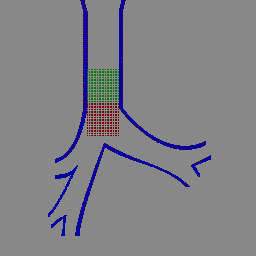IBIS
A software system for immersed boundary
and interface simulations
Availability and Requirements
WARNING: IBIS and this webpage are in the alpha development stage.
IBIS for Sun operating systems is available for download
here.
The package is designed to run on SGI workstations that have
OpenGL.
For full functionality, IBIS requires the following freeware, which
can be provided with the IBIS software package.
Example: Ciliated Tenticle
To produce a simulation similar to the cilliated tenticle simulation
demonstrated on the IBIS index page, a user
is required to write a short IBIS program the defines
the initial conditions, properties of the fluid, and properties of the
immersed boundary. The user is also required to write a short
FORTRAN subroutine to specify the motion
of the immersed boundaries.
The IBIS package contains a set of programs that are designed to
make it simple to perform an immersed boundary simulation. Once
the IBIS and FORTRAN programs have been written, to execute the
software, the user is required to type only
a few commands at the prompt.
With these short programs and instructions, IBIS will produce data to create
this animation.
To analyze and visualize the data in more detail, IBIS includes a
graphical user interface to study the details of the simulation called
ibisview.
This program allows one to see animations of the data,
line plots that include velocities, immersed boundary positions,
force fields, and scalar quantities like pressure fields.
Example: Aerosol transport in branched bronchi

|
IBIS is being used to study the flow and aerosol transport properties
in a model of a segment of bronchial tissues. This simulation is part
of a modeling effort to understand how high frequency ventilation works.
This mixing is an important process in ventilation and drug delivery, but
we have a only a poor understanding of how it is accomplished.
The IBIS file required to create this simulation uses
polynomials to define the boundary of the bronchi, and reads particle positions
from a user specified file. The first and second columns
of this file define the initial positions of the particles, and the third number
assigns the particles a color. The flow in this simulation was generated by a
sinusoidally oscillating cone that is defined in a short
FORTRAN subroutine.
|
With these short programs and instructions, IBIS will produce data to create
the animation shown on the left. The animation continuously loops, and there
is a five second delay between successive loops. Notice the preferential flow
into the right branch, the mixing of the aerosol particles and the distance those
particles travel.
|
Applications of the Immersed Boundary
Method
- Studies of the beating heart in 2 and 3 dimensions
- Studies of platelet aggregation at the site of a blood vessel injury
- Studies of aquatic animal locomotion
- Studies of the cochliar membrane of the inner ear
- Studies of blood flow in renal blood vessels
- Studies of particle sedimentation
- Studies of the effectiveness of ciliated pumping
- Studies of biofilm deposition
- Studies of fluid flows in flexible tubes
- Studies of air flows in lung tissues
- Studies of locomotion mechanisms in amoeba
- Studies of internal flagelar dynamics
IBIS Programming Language
The IBIS programming language is a tool that was designed to allow users
to easily set the parameters that are needed for an immersed boundary
simulation. These parameters include the domain, the initial positions
of the immersed boundaries, the properties of the elastic links of the
immersed boundaries, and the viscosity, density and initial fluid velocities.
The IBIS programming language has less than 50 key words, and each word
has a small set of modifiers. Each of these key words specifies a unique
property for the simulation.
The IBIS preprocessor interpretes the initial data, makes the numerical
software, and graphically displays the initial positions of the immersed
boundaries.
IBIS Numerical Software
The IBIS numerical software is written in FORTRAN. It takes the parameters
set by the user, and calculates the evolution of the system. The IBIS
package has been designed specifically to allow the user to avoid the
internal working of the immersed boundary method, and the numerical software.
For those problems that require forcing of all or part of the the immersed
boundary, an interface to a user defined FORTRAN subroutine has been provided.
In this interface, the immersed boundary and fluid data is passed to the user
in a managable format, and can then be manipulated as needed.
IBISVIEW Visualization Interface
The IBIS graphics tool is called ibisview. The interface provides
the user with point and click access to the data computed by IBIS. The
data has two basic modes, color plots and line plots. The color plots are
used to animate the simulations, and the line plots are used to study the
data in more detail. With a point and click, ibisview can be used
to see animations, to zoom-in to see detailed interface positioning and
velocities, or to see the flow field on large or small scales.
IBIS Manual
The IBIS manual describes the software
package, the IBIS programming language and the ibisview
graphical interface.
DISCLAIMER:
This software is made available "as is" without any assurance that it
will work for your purposes. The software may in fact have defects, so
use the software at your own risk.
